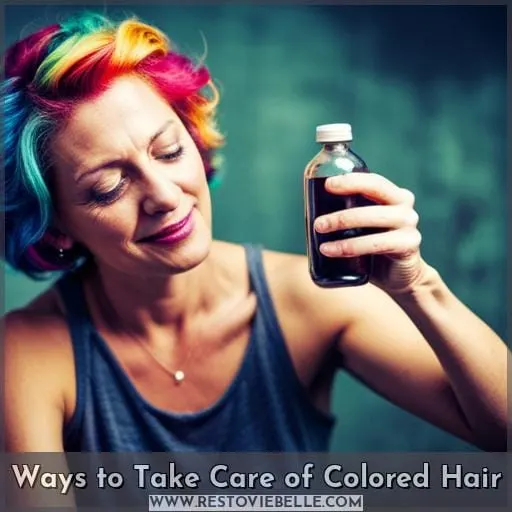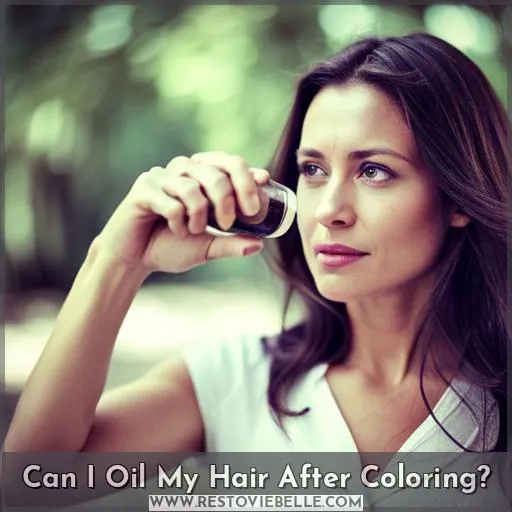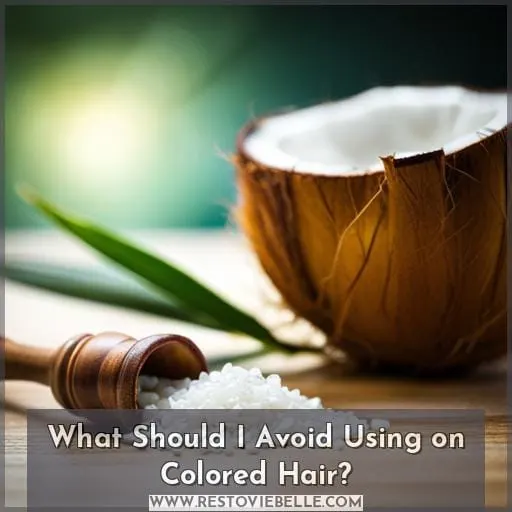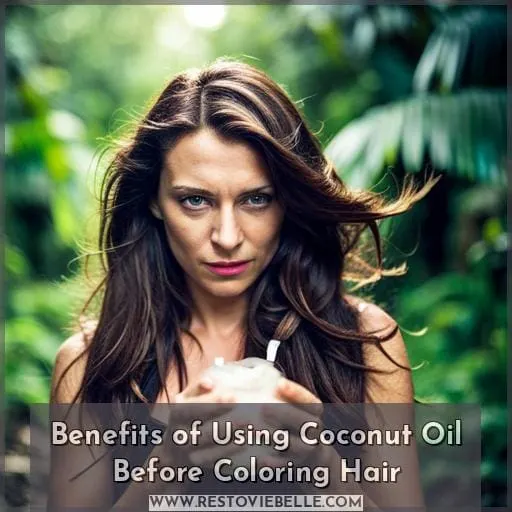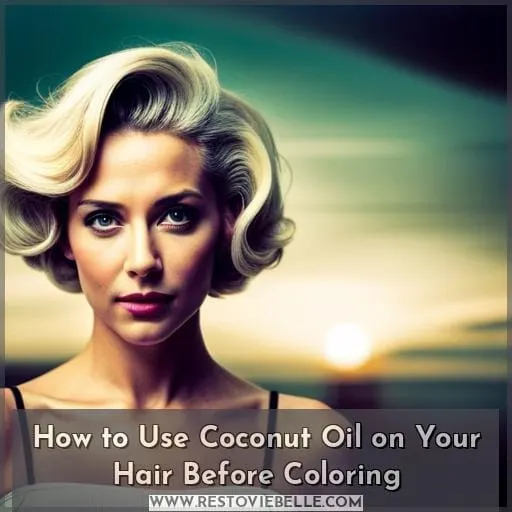This site is supported by our readers. We may earn a commission, at no cost to you, if you purchase through links.
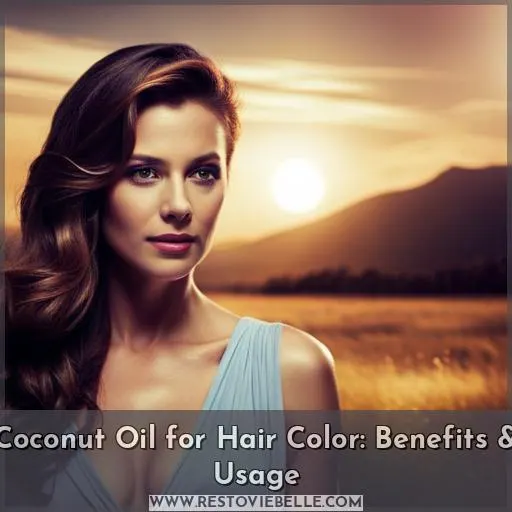 Imagine having vibrant, luscious hair color that lasts longer and looks healthier. Well, you can achieve just that with the help of coconut oil for hair coloring! This miraculous ingredient not only nourishes and hydrates your colored locks but also prevents frizz and chemical damage.
Imagine having vibrant, luscious hair color that lasts longer and looks healthier. Well, you can achieve just that with the help of coconut oil for hair coloring! This miraculous ingredient not only nourishes and hydrates your colored locks but also prevents frizz and chemical damage.
In this article, we’ll explore the incredible benefits of using coconut oil before coloring your hair and how to incorporate it into your hair care routine.
Table Of Contents
Key Takeaways
- Nourishes and hydrates the hair
- Helps eliminate frizz
- Can help prevent protein loss from the hair shaft
- Can help prevent hair loss
Ways to Take Care of Colored Hair
To maintain the vibrancy and longevity of your colored hair, it’s essential to take proper care.
Keep your hair hydrated by:
- Deep conditioning regularly
- Using a leave-in conditioner
Wait at least 48 hours before shampooing after coloring to allow the color to set, and opt for sulfate-free shampoos that won’t strip away color.
Additionally, consider getting touch-ups every 6-8 weeks to keep your color looking fresh, or add a pinch of dye to your conditioner as an easy way to refresh it between salon visits.
Keep Your Hair Hydrated
To keep your colored hair hydrated, prioritize regular deep conditioning.
Deep condition your hair at least once a week to replenish moisture and nourishment.
Avoid using harsh chemicals that can strip the color and further dry out your hair.
After washing, rinse with cold water to seal the cuticles and lock in hydration.
Use a leave-in conditioner for added protection throughout the day.
Remember to wait 48 hours before shampooing after coloring to allow the color to set properly.
Wait Before Shampooing
After coloring your hair, it’s important to give your new color time to set and fully penetrate the hair shaft before shampooing.
Using a sulfate-free shampoo when you do wash your colored hair can also help preserve the vibrancy of the color.
Limiting how often you shampoo can prevent excessive fading and allow for better maintenance of your colored hair.
Get Touch-Ups Frequently
To maintain the vibrancy and freshness of your colored hair, it’s important to get touch-ups frequently.
Touch-ups can help keep your color looking fresh and prevent fading.
Schedule touch-ups every 6-8 weeks to ensure that your roots are covered and any faded areas are touched up.
The frequency of touch-ups may vary depending on how quickly your hair grows and how noticeable the regrowth is.
Consult with a professional stylist to determine the best timing for touch-up appointments based on your specific needs.
Go for a Sulfate-Free Shampoo
When taking care of colored hair, it’s important to go for a sulfate-free shampoo.
Sulfates can strip color from your hair, causing it to fade quickly.
By using a sulfate-free shampoo, you can ensure that your color lasts longer and stays vibrant.
Look for shampoos specifically formulated for colored hair that are gentle and nourishing.
These products will help protect your color while keeping your hair healthy and shiny.
Add a Pinch of Dye
To maintain the vibrancy of your colored hair, enhance and refresh your color by adding a pinch of dye to your conditioner.
This simple trick can help extend the life of your color and keep it looking fresh between salon visits.
The amount of dye you add will depend on how intense you want the color to be. Experiment with different amounts until you achieve your desired shade.
It’s important to consider both the type of hair and brand/color dye used when determining how much to add.
Can I Oil My Hair After Coloring?
After coloring your hair, you may be wondering if it’s okay to oil your hair. The good news is that coconut oil can actually benefit your colored hair.
Contrary to popular belief, coconut oil doesn’t fade hair color. In fact, it can help preserve the vibrancy of your color by moisturizing and nourishing the strands.
To use coconut oil for after-color care, apply it as a pre-poo treatment before shampooing your hair. This will help protect and hydrate the strands while preventing damage caused by chemical processes like dyeing or bleaching.
So go ahead and incorporate coconut oil into your post-coloring routine for healthier and more vibrant-looking locks!
What Should I Avoid Using on Colored Hair?
When it comes to colored hair, there are a few things you should avoid using.
First, hot water can strip the color from your hair and cause fading.
Second, strong shampoos with harsh chemicals can also fade your color and damage your strands.
Lastly, heat styling tools like flat irons and curling wands can further compromise the vibrancy of your color.
To maintain the longevity of your colored hair, steer clear of these culprits that could sabotage all those hours spent in the salon chair.
Hot Water
Avoiding hot water is important for preserving the color of your hair after coloring.
Hot water fades color and strips away the vibrant hues you worked so hard to achieve. It opens up the cuticle, allowing the dye molecules to escape, resulting in fading and dullness.
Additionally, hot water can dry out your hair, leaving it brittle and prone to breakage.
To maintain your colored hair’s vibrancy and health, opt for lukewarm or cool water when washing or rinsing your locks.
Strong Shampoos
Don’t use harsh shampoos on colored hair.
They can strip the color and leave your hair dry and damaged.
Instead, use a gentle shampoo that’s specifically designed for colored hair.
Heat Styling
Avoid using heat styling tools on your colored hair as much as possible to prevent fading and damage.
Heat can dry out your hair, make it frizzy, and strip away the color.
If you do use heat styling tools, be sure to use a heat protectant spray to help protect your hair from damage.
Frequent Washing
To maintain the vibrancy of your colored hair, it’s important to minimize frequent washing.
Washing too often can strip away the color and cause it to fade faster.
When washing colored hair, avoid using strong shampoos that contain harsh chemicals and sulfates.
Opt for gentle sulfate-free shampoos instead.
Additionally, hot water should be avoided as it can also contribute to color fading.
By reducing how often you wash your hair and choosing gentle products, you can help preserve your beautiful hair color for longer periods of time.
Chlorine
If you swim frequently in chlorinated pools, it’s important to be aware that chlorine can have a negative impact on colored hair.
Here are some things to avoid when it comes to chlorine and colored hair:
- Chlorine can cause your hair color to fade faster.
- It may lead to dryness and damage.
- Chlorine can also make your hair more porous, causing it to absorb minerals from the pool water that can alter its color.
Taking steps like wearing a swim cap or rinsing your hair with fresh water before swimming can help protect your colored locks.
Benefits of Using Coconut Oil Before Coloring Hair
Using coconut oil before coloring your hair offers several benefits.
Firstly, it nourishes and hydrates the hair, helping to prevent dryness and damage from the chemicals in the dye.
Secondly, it helps eliminate frizz, leaving your hair smooth and manageable after coloring.
Lastly, coconut oil can help prevent protein loss from the hair shaft during the coloring process, minimizing breakage and promoting healthy growth.
Nourishment and Hydration
To nourish and hydrate your hair before coloring, apply coconut oil as a pre-poo treatment.
Coconut oil has numerous benefits for your hair. It helps prevent hair breakage, promotes faster hair growth, reduces shedding, makes your hair shinier, and softens it.
By using coconut oil before coloring your hair, you can ensure that it stays healthy and vibrant throughout the process.
Frizz Elimination
You can eliminate frizz by using coconut oil before coloring your hair.
Coconut oil is a great option for taming unruly strands and achieving smoother, sleeker hair. It works by deeply moisturizing and nourishing the hair shaft, reducing porosity and improving overall texture.
Whether you have fine or thick hair, curly or straight, coconut oil can help control frizz and create a polished look. Incorporating this natural ingredient into your pre-coloring routine can make a noticeable difference in managing frizzy locks.
Chemical Damage Prevention
In addition to preventing frizz, coconut oil can also help protect your hair from chemical damage caused by hair coloring.
- Coconut oil coats the hair shaft, creating a barrier against harsh chemicals.
- Coconut oil helps to retain moisture, which can help to prevent hair from becoming dry and brittle.
- Coconut oil can help to repair damaged hair.
- Coconut oil can help to strengthen hair and prevent breakage.
- Coconut oil can help to improve the overall health of your hair.
Protein Loss Prevention
Does coconut oil prevent protein loss from hair coloring?
Yes, coconut oil can help prevent protein loss from hair coloring by acting as a sealant on the hair shaft. This helps to keep moisture in and protect the hair from the damaging effects of chemicals.
Hair Loss Prevention
Protein loss prevention is just one of the many benefits of using coconut oil before coloring your hair.
Applying coconut oil to your hair before bleaching or dyeing it can help to protect the hair from damage and prevent hair loss.
How to Use Coconut Oil on Your Hair Before Coloring
To protect your hair from damage, apply coconut oil to your hair before coloring.
Wash your hair and apply a generous amount of coconut oil to your hair.
Cover your hair with a shower cap and let it sit overnight.
The next morning, shampoo and condition your hair as usual.
Clean Your Hair
Before applying coconut oil to your hair, you need to clean it. Here’s how:
- Wash your hair with cold water: Cold water helps seal the cuticles and prevent color fading.
- Use a sulfate-free shampoo: Sulfates can strip away color, so opt for a gentle cleanser that won’t harm your vibrant locks.
- Avoid heat styling: Heat can cause color to fade faster, so give hot tools a break.
- Use a leave-in conditioner: This will help keep your hair moisturized and protect the color from damage.
Apply Coconut Oil Before Bed
To prepare your hair for coloring, apply coconut oil before bed to nourish and protect it. This will help prevent damage from the chemicals in hair dye and keep your strands hydrated.
Wondering how long to leave coconut oil in hair before bed? It’s best to leave it on overnight for maximum benefits.
Use enough coconut oil to cover all of your hair, focusing on the ends if they’re dry or damaged. Don’t worry about making your hair greasy – coconut oil absorbs easily into the strands without leaving a heavy residue behind.
| Benefits | Usage |
|---|---|
| Nourishes and hydrates | Apply enough to cover all |
| hair, focusing on dry or | |
| damaged ends | |
| Makes Hair Less Greasy | Leave overnight |
Remember that applying coconut oil before bed isn’t only beneficial for color-treated hair but also great for those with naturally dry or damaged locks.
Bleach and Dye Hair as Usual
Once you have applied coconut oil to your hair before bed, it’s time to bleach and dye your hair as usual.
- Coconut oil helps the color last longer by moisturizing the hair.
- It makes the hair color appear brighter and more vibrant.
- The use of coconut oil ensures that the color is even throughout the strands.
- Coconut oil prevents brassy tones in colored hair, keeping it looking fresh and beautiful.
Wash and Condition Hair With Gentle Shampoos
After you have bleached and dyed your hair as usual, it’s time to wash and condition your hair with gentle shampoos.
To preserve the color and health of your colored hair, avoid sulfates, heat, hot water, and shampooing too often.
Instead, opt for sulfate-free shampoos that are designed specifically for color-treated hair.
Additionally, make sure to use a conditioner after every wash to keep your locks hydrated and nourished.
Make Coconut Oil a Part of Your Hair Care Regimen
Include coconut oil as an essential part of your hair care routine to maximize its benefits before coloring. This will help to nourish and hydrate your hair, reduce frizz, and prevent chemical damage.
Choose a product that’s formulated for your hair type and porosity, and apply it to your hair before bleaching or dyeing.
Frequently Asked Questions (FAQs)
What are some common ingredients to avoid in hair care products for colored hair?
When it comes to hair care products for colored hair, it’s important to avoid certain ingredients.
Stay away from:
- Sulfates
- Heat styling tools
- Hot water
- Shampooing too often
How often should I touch up my colored hair?
To maintain vibrant colored hair, touch-ups are key.
Schedule them every 6-8 weeks to keep your color looking fresh and beautiful.
Stay in control of your style with regular maintenance for lasting results.
Can heat styling tools damage colored hair?
Heat styling tools can damage colored hair by:
- Causing the color to fade
- Making it more prone to breakage
To protect your hair, use:
- Heat protectant products
- Lower heat settings on your styling tools
Does chlorine in swimming pools fade hair color?
Investigate the truth: Does chlorine in swimming pools fade hair color?
Chlorine can strip away color molecules, leading to fading.
Protect your colored hair by wearing a swim cap or rinsing with fresh water before and after swimming.
Is it necessary to use a specific shampoo for colored hair?
Using a specific shampoo for colored hair is necessary to maintain the vibrancy and longevity of your color.
These shampoos are formulated to be gentle, sulfate-free, and help lock in the color while keeping your hair healthy and vibrant.
Conclusion
Say goodbye to dull, damaged hair and hello to vibrant, luscious locks with the help of coconut oil for hair coloring! This miraculous ingredient will nourish, hydrate, and protect your hair from the damaging effects of chemical dyes.

